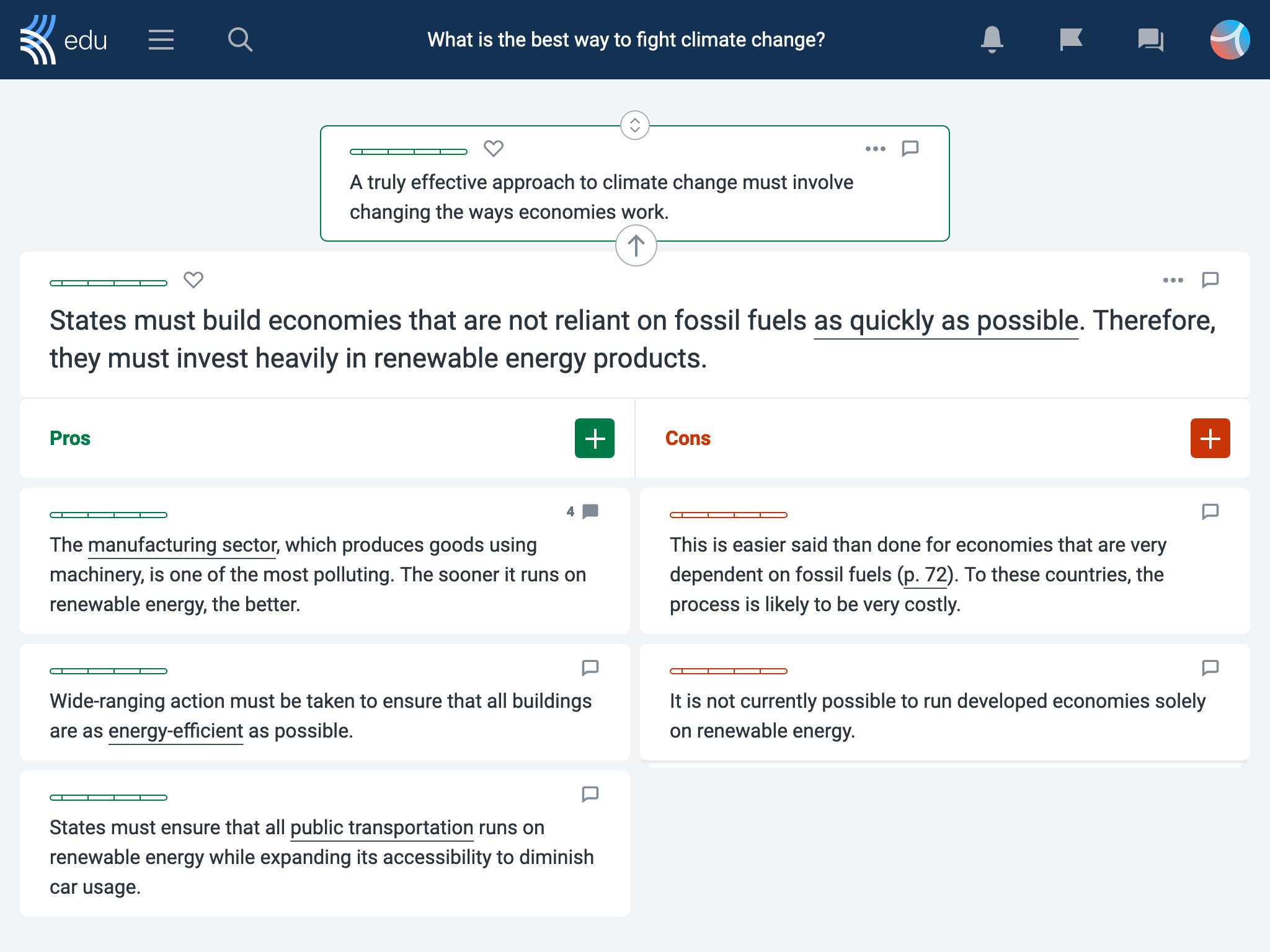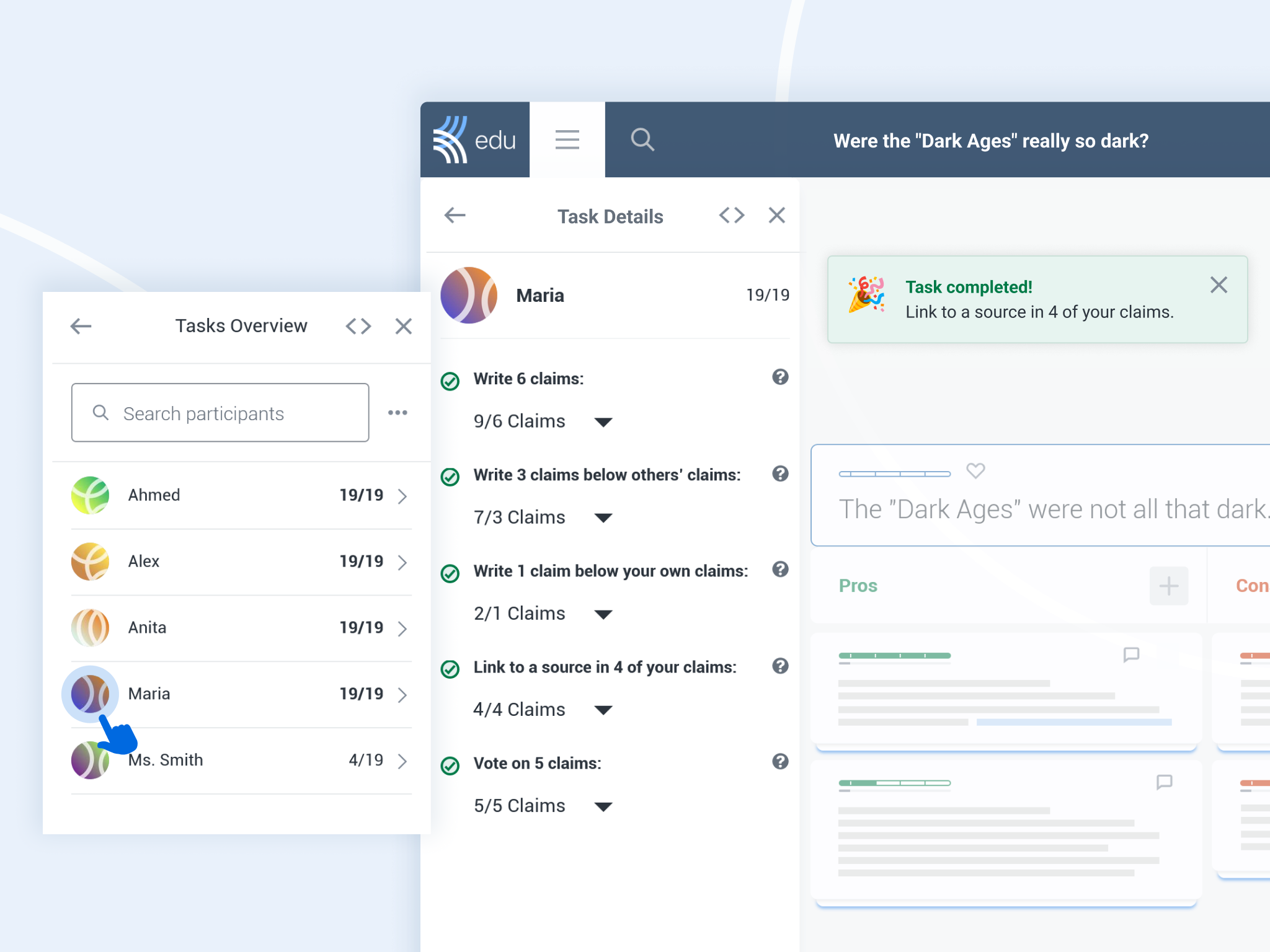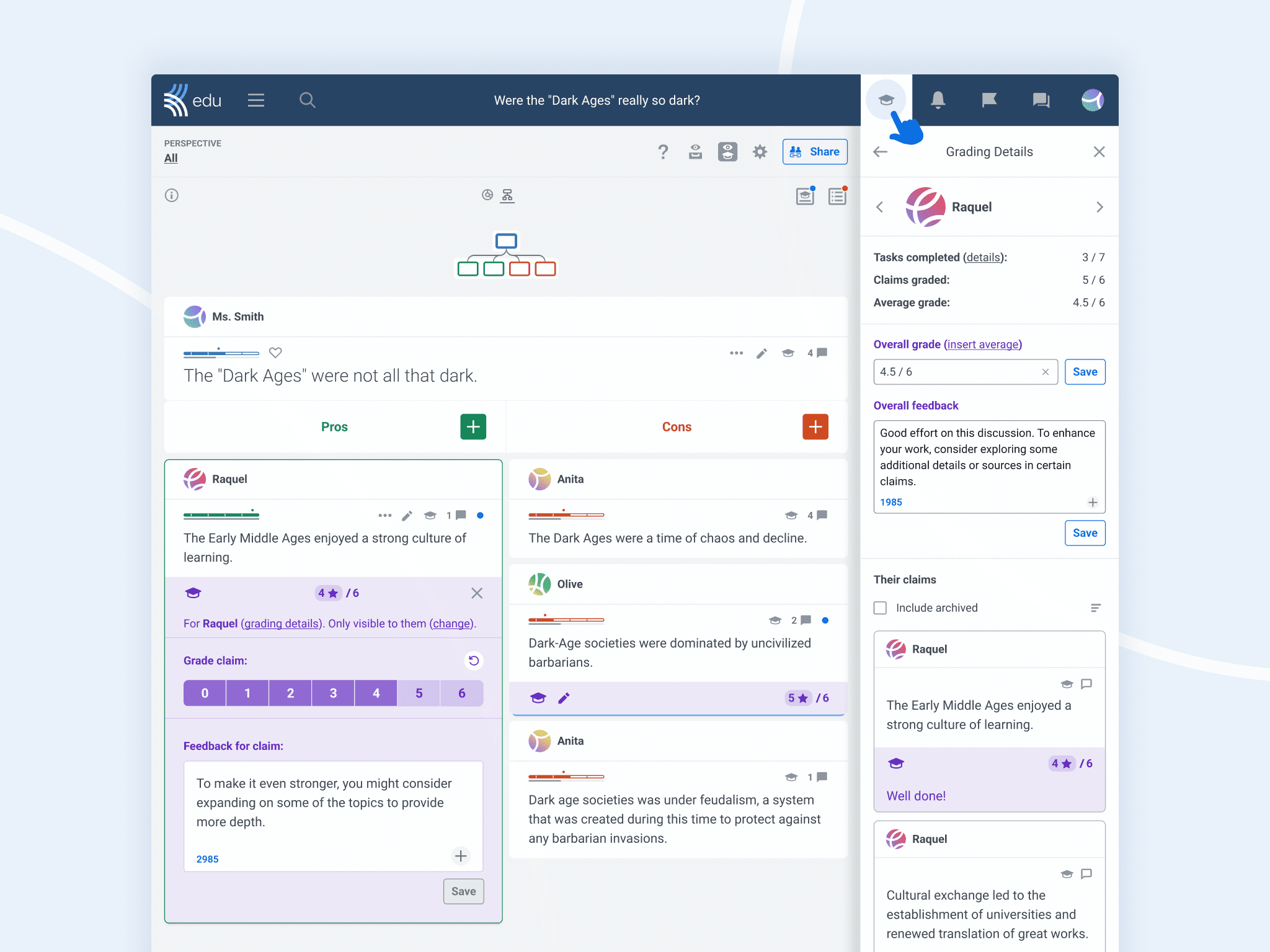Class discussions are a popular activity and it’s easy to see why: As a powerful active learning strategy, class discussions can significantly boost students’ engagement with learning. And this is crucial, given the positive impact that high levels of engagement have on students’ grades and attitudes.
But traditional class discussions don’t always capture students’ attention, so it’s time to shake things up! Let’s explore different discussion formats that you can use to elevate student engagement — including how you can use Kialo Edu to reap the many benefits of online class discussions!
What are the features of successful class discussions?
A class discussion is a pedagogical approach for students to exchange information and ideas. In a successful discussion, students actively process and respond to content, cultivating a range of essential life skills.
Successful class discussions have a clear focus or goal that promotes student engagement. Here, problematizing the discussion topic can help.
For example, instead of instructing students to discuss climate change, try asking them whether people should have fewer children to tackle the problem, or if individuals should assume responsibility for climate change. This gives the discussion a clear purpose.
The most engaging class discussions follow a dialogic model that emphasizes peer-to-peer interaction and encourages students to construct knowledge collectively. And this doesn’t have to be within synchronous verbal exchanges — written, online, and asynchronous discussions are also great for boosting student engagement!
What are the benefits of class discussions for students?
1. Students learn civil discourse skills
Engaging in class discussions teaches students how to communicate respectfully, particularly with people who hold differing views. Students learn to reach a consensus by managing disagreements constructively, an important skill in democratic societies.
2. Students develop critical thinking skills
Open-ended discussions require students to move beyond simple “yes” or “no” responses. Instead, students must engage their critical thinking skills to analyze topics and reason through evidence to support their viewpoints.
3. Students practice active listening
During discussions, students can practice active listening by paying attention to their peers’ points without interrupting, while giving non-verbal affirmations. To demonstrate their understanding, students learn to paraphrase or summarize their peers’ contributions before responding appropriately.
4. Students engage with multiple perspectives
Class discussions enable students to explore diverse perspectives on a topic, providing valuable insights into different experiences, beliefs, and values. This helps students in looking beyond their own perspective to combat the echo chambers they may encounter online and in society.
How can I increase student engagement with class discussions?
1. Create a comfortable, student-centered environment
Creating a safe and inclusive space for discussions promotes student engagement. Educators can foster this environment by emphasizing that every student has a voice and every idea contributes to collective knowledge-building.
2. Give students a sense of ownership
Moving from teacher-led to peer-to-peer discussions empowers students to take ownership of their learning. Instead of students passively receiving information, they actively engage in discussions by contributing ideas, shaping conversations, and taking responsibility for outcomes.
3. Encourage student collaboration during the discussion
Collaborating toward a common goal in discussions can relieve individual pressure, which in turn enhances students’ enjoyment and engagement with the discussion topic. Moreover, students feel an added sense of responsibility toward their peers for the discussion’s outcome, strengthening their active involvement.
4. Discuss relevant, real-world topics
Selecting real-world topics that resonate with students, such as climate change, mental health awareness, or social justice, helps them engage more effectively as they relate the topic more directly to their own lives. Students can draw on their own experiences, perspectives, or ideas to make more thoughtful contributions to the discussion.
Group discussion activities to increase student engagement

These live, in-person group discussions are great for giving students ownership of discussions to boost their engagement with curriculum and real-world discussion topics!
Socratic seminar
Socratic seminars are structured discussions where students explore a question, topic, or text through meaningful dialogue and critical thinking. Students prepare contributions and questions in advance, so they can lead the seminar, collaboratively investigating issues and building knowledge. This ownership drives students’ engagement in discussions.
Mock trial
Mock trials offer a multitude of courtroom roles, such as defendant, prosecutor, and jury, to engage the entire class in discussions on real-life or fictional moral issues. To prepare, give students time to explore their role, formulate questions, and develop responses, so they can meaningfully engage in the trial. Then have each character present evidence or raise challenges before the jury convenes to discuss the final verdict.
Conversation clusters
In this problem-solving activity, students are separated out into small clusters to actively participate and contribute to a wider discussion. Assign each cluster of students a specific aspect of a problem to focus on and brainstorm potential solutions, with a designated student acting as the facilitator. Each cluster then shares their ideas with the class, contributing to an overall solution.
Fishbowl discussion
In a fishbowl discussion, a central group actively engages in a discussion, while their peers observe and evaluate from the outside. This motivates the central group to actively engage in conversation, while the outer group has the responsibility of actively listening and reflecting to give feedback after the discussion.
Active discussion activities to increase student engagement
Getting students up from their desks helps them to remain alert and engaged during these dynamic discussion activities!
Walk and talk
Place stimulus materials, such as images or extracts, around the room, along with targeted questions. Students move around the stations, discussing responses to the questions and recording ideas on shared documents. This active movement engages students as they encounter different perspectives.
Turn and talk
Organize students into two concentric circles, with the inner circle facing the outer circle. Pairs of face-to-face students then engage in discussions on the designated topic or scenario. When prompted, the inner circle rotates, so students can discuss ideas with a new partner. Each rotation presents students with the opportunity to share new perspectives and modify their own viewpoint.
Continuum conversation
Create a continuum line in the classroom, marked with different positions representing various levels of agreement or viewpoints. Give students a scenario and instruct them to stand on the continuum according to their viewpoint. Students then discuss their perspectives as a whole class, in groups from different parts of the continuum, or in groups from the same part of the continuum, depending on the discussion objective.
Online discussion activities to increase student engagement
With students growing up as digital natives and becoming 21st-century learners, one surefire way to engage them is to use platforms they’re most comfortable with: Having online class discussions on digital devices can revolutionize student engagement!
Silent support discussion
During focused learning tasks, try having online silent discussions on student devices. Through chat or discussion features in online discussion tools such as Kialo Edu, students can share ideas, signpost peers to useful research sources, or answer each other’s questions — all without disrupting lessons. Moreover, educators can monitor all conversations to ensure students remain on-task — no more trying to figure out if all those whispers really are learning-related!
Asynchronous discussion
Asynchronous discussions, such as those on discussion boards, promote flexible collaboration among students, extending their in-class learning. After learning about a topic, students can reflect on what they’ve learned and develop responses at their own pace.
With carefully designed prompts on the discussion board, students are able to more deeply engage with course content. Moreover, giving students the freedom to choose when they contribute increases their sense of responsibility and thus boosts their engagement levels.
Kialo Edu discussions

Kialo Edu discussions are designed to engage students in deep exploration of real-life topics. Whether you create your own discussion topic or use one of our ready-made discussions in the Topic Library, you can easily prompt students to contribute their own ideas after starting them off with a debatable thesis and some top-level claims.
Then, the pro/con structure of the discussion visually maps out arguments and encourages students to write concise, high-quality claims, making the discussion feel more manageable and helping to boost students’ engagement.
To further fuel student engagement, try assigning students Tasks within discussions, such as writing a specific number of claims. Each time they complete a task, students see a celebratory checkmark, helping them remain motivated and focused.

Finally, educators can use Grading and Feedback to quickly provide positive reinforcement — or intervene when students need additional guidance to keep them engaged!

So, prepare to revolutionize your class discussions with these engaging discussion formats! Give them a try to elevate your students’ engagement, so that they can fully immerse themselves in their learning and reap the many benefits.
We’d love for you to join the discussion on increasing student engagement in the classroom. Contact us at feedback@kialo-edu.com or on our social media channels.

